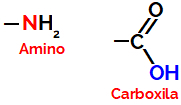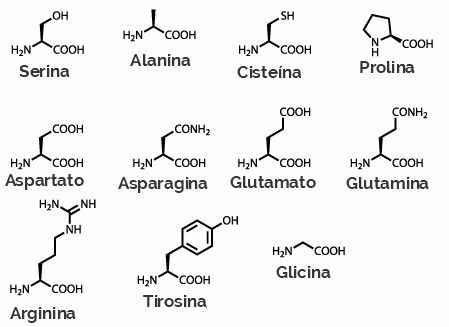amino acids are organic substances that have in their constitution two different functional groups: a carboxyl (referring to the carboxylic acids) and an amino (referring to the mine).

Carboxyl and amino functional groups
In the structure of a amino acid, the amino group and the carboxyl group are not directly linked. In fact, they are linked indirectly, as the amino group is always linked to carbon number 2 in the chain.

General structural formula of an amino acid
Generally speaking, a amino acid is referred to as α-amino acid. The term alpha indicates that the amino group in any amino acid is attached at carbon 2 from the carboxyl.
the union of two or more α-amino acids leads to the formation of proteins, macromolecules that have several important functions for an organism. Among the functions of proteins, we can mention:
Structural: construction of tissues in the body, such as muscle;
Enzymatics: formation of enzymes that act in chemical reactions;
Defense: in the formation of antibodies;
Transport: transport of triglycerides and cholesterol, for example;
Hormonal: production of hormones.
Types of amino acids
There are 20 α-amino acid common: alanine, arginine, aspartate, asparagine, cysteine, phenylalanine, glycine, glutamate, glutamine, histidine, isoleucine, leucine, lysine, methionine, proline, serine, tyrosine, threonine, tryptophan and valine.

Structural formulas of essential amino acids
Do not stop now... There's more after the advertising ;)
However, from these amino acids, the human body cannot synthesize (produce) nine of them: histidine, lysine, leucine, methionine, isoleucine, phenylalanine, threonine, tryptophan and valine. For this reason, they are called essential amino acids and must be obtained obligatorily in food. The other 11 are produced by the organism itself and are called non-essential amino acids.

Structural formulas of non-essential amino acids
In food, the amino acids they are present in the form of proteins. When consumed, our body breaks down protein molecules in digestion, thus favoring the use of amino acids in a specific way.
Amino Acid Sources
Check out a list of foods that have proteins in their constitution, that is, sequences of amino acids:
Beef;
Pig meat;
Birds;
Fish;
Eggs;
Rice;
Wheat;
Corn;
Lentil;
Nuts (almonds, peanuts, from Brazil, cashew, etc.);
Milk and its derivatives (yoghurt, cheese, etc).
Importance of amino acids
Specifically, the essential amino acids are important for our body because they participate in:
Red blood cell production;
Antibody production;
Production of important hormones such as serotonin;
Cell regeneration (from the skin, for example);
Promotion of the feeling of satiety in the brain after eating.
By Me. Diogo Lopes Dias
Would you like to reference this text in a school or academic work? Look:
DAYS, Diogo Lopes. "What is an amino acid?"; Brazil School. Available in: https://brasilescola.uol.com.br/o-que-e/quimica/o-que-e-aminoacido.htm. Accessed on June 28, 2021.
Chemistry

Peptides, elemental unit in the constitution of a protein, Amine function, Carboxylic acid function, amphoteric compounds, essential amino acids, valine, lysine, tryptophan, leucine, isoleucine, phenylalanine, methionine, threonine, composition of nucleopro
